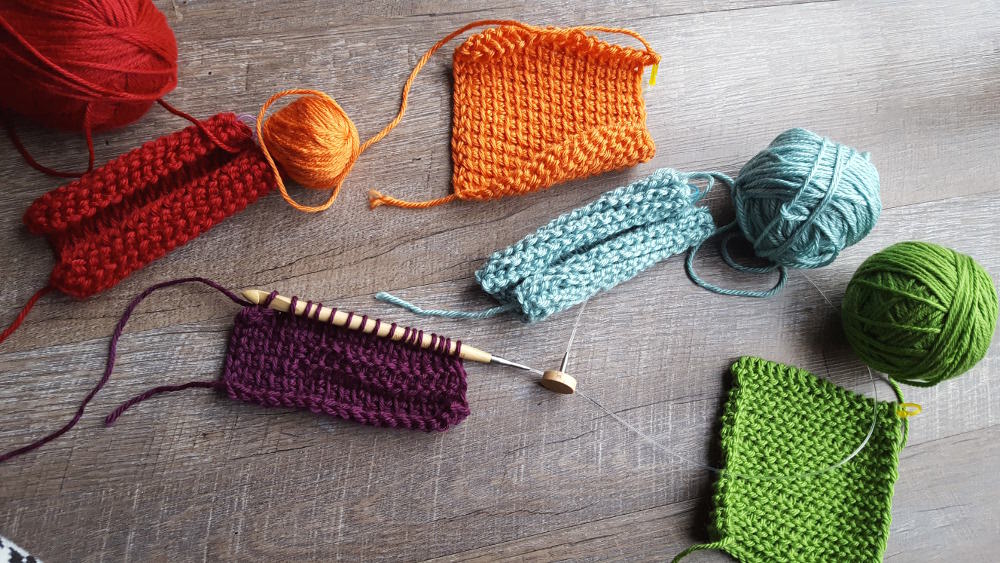
By Amber Millard | Divine Debris
Hi everyone, I’m Amber the designer from Divine Debris. A little bit about me – my mother taught me to crochet when I was a kid but didn’t start again until I was in my 20s. I started designing a couple years ago and when I found I had a lots of ideas and needed to work them out. And that’s kind of it for my backstory, once I discovered designing I haven’t stopped, it combines my childhood dream being a fashion designer with my love of being artistic.
For a few years now I’ve had Tunisian crochet in the back of my mind as a “must learn someday” skill but, to be honest, I have been intimidated by it. From what I could tell, it was like crochet but also, not exactly. I also wasn’t sure if I would be able to pick it up without getting so frustrated by it I just put it away and never try again. That may or may not be exactly what happened when I tried to learn how to knit about 4 years ago. One of these days I’ll try it again, I swear.
Anyway, because my friends Lee (of Coco Crochet Lee), and Rohn Strong are making some gorgeous things with Tunisian I started really wanting to learn.
Full disclosure, Clover did send me this amazing set of Interchangeable Tunisian Crochet Hooks for free but there were no expectations for my review to be influenced by that. My feelings on this are entirely my own.
So about a month ago, armed with a brand new set of hooks, I set about teaching myself Tunisian crochet. Luckily there’s the internet. Some days I forget how fortunate we are to live in a time where, to learn a new skill, all I need to do it type it into the search bar. Designers like Tamara from Moogly, Kim from CrochetKim, Kristine of Ambassador Crochet, and so many more have taken the time to make tutorials and videos who help people wanting to be creative.
Over the course of two days, I fell in love with this one-time intimidating technique.

When I first opened the package I saw the cords and rubber stoppers I didn’t know what do think of them. I’ve seen Tunisian hooks at the store, the long metal ones that looked like knitting needles with crochet hook ends but I couldn’t remember having seen interchangeable ones. So when I sat down to learn I pulled out the longest cord and a stopper and started working, on swatches. This was after I tried to attach a stopper directly to one of the hooks and no, that doesn’t work. Needless to say, I’m glad they’re easy to change out as I most definitely didn’t need so much cord for a 4” x 4” swatch of fabric. Once I got the correct cord and hook all sorted, learning came very quick to me and I just had a blast with my new hooks.

You may not know but April is Stress Awareness Month and, if I do say so myself, it’s a great time to learn some Tunisian. I don’t want to over-sell it, but I really did love how I was able to lean into the relaxation of Tunisian and stitch away the stress as they say. 🙂 Personally, I really did need those moments of repose, as my life currently is full of cleaning, packing, and planning a move and it’s making me tear my hair out with frustration. Tunisian has been a delightful new discovery that I look forward to. Honestly, I might make a blanket with my new hooks and I’m not a blanket making person at all. That’s how much I liked it.
So, in short, I’m so glad I pushed myself out of my comfort zone and tried out a new technique. I hope that my post here has encouraged you to do the same. It’s really not as intimidating as it looks and it’s actually really fun. Like I said, that return pass feels so satisfying and it really helped me to de-stress with Tunisian. And I have a new shrug to cozy up with and wait for this long winter season to pass.
If you’d like the pattern for my Tasha Tunisian Shrug you can view it on my blog here or buy it in my Ravelry shop here. Check out my weekly patterns on my blog, and follow me on Instagram or Facebook to stay connected.